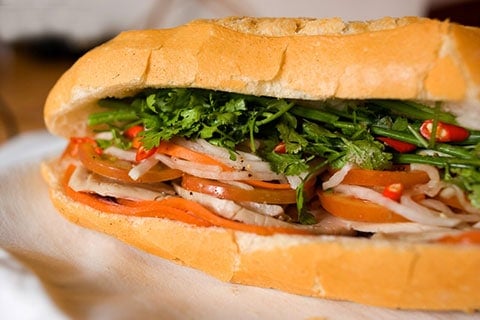Before delving into Saigon’s rich street food culture, it is helpful to know what makes Vietnamese street food cuisine special. Why does it beat local restaurant food 90% of the time? How was street food culture born? Where should you get certain dishes? And how can you make your Vietnamese street food experience the best it can be?
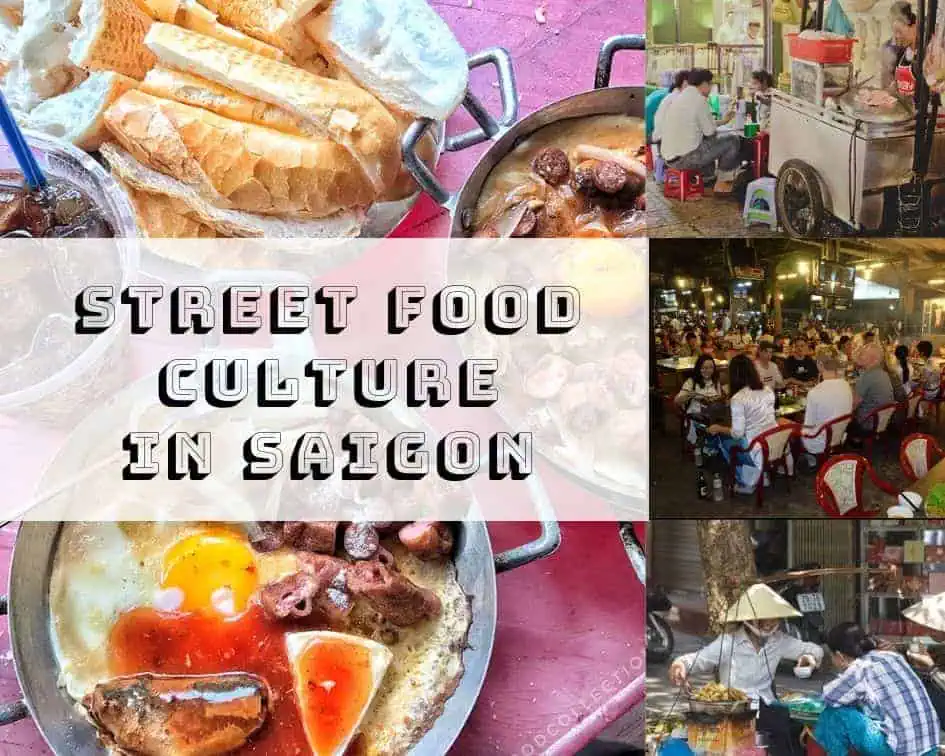
It’s true that Vietnamese street food cuisine is an integral part of Vietnamese culture. Out of 10 million+ people living in Saigon, over 1 million of them sell street food for a living. Celebrity chef Anthony Bourdain said that he would rather eat at one of Vietnam’s delicious and authentic street food stalls than most 5-star restaurants any day. It has even been said that Vietnam’s street culture is a microcosm of the country’s culture in general. For visitors, exploring the scene is one of the most popular things to try in Vietnam. For locals, it is a way of life.
(Please click on the link below to jump directly to the section you would like to explore)
Vietnamese Street Food: Pros and Cons
It is common knowledge that street food is cheap and convenient. But the fact that it is so popular in cities throughout Vietnam is due to more than just accessibility. In fact, street cuisine provides a tastier and ultimately more satisfying dining experience than a restaurant can most of the time. Why is this?
Firstly, street food cuisine tastes better because it is fresher and uses more hearty flavors. It makes excellent use of fats, acids, and crunchy vegetables to achieve its desired flavors and textures. More so than restaurants, street food vendors focus on using only fresh ingredients just bought from the local market that very morning. Successful stands do not have a choice, in fact, because they have massive turnover and sell everything they stock. It is not uncommon for a particularly popular street food location to close up shop a bit early because they run out of ingredients due to demand.
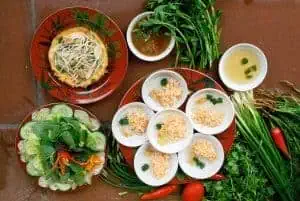
The smell of a Vietnamese street food experience is another thing that helps it get the leg up on restaurant eating. The olfactory aspect of the dining experience is often overlooked, but the truth is that the smells hanging around you while you are eating will drastically alter the perceived taste. Street food establishments do not have a separate kitchen to keep the cooking smells away from the diners, and customers can have a more immersive dining experience because of that fact. Vietnamese street food locations tend to be clustered together, too, so customers can take in the aromas of multiple foods being prepared while eating.
Possibly the biggest reason most people love Vietnamese street food, though, is because of the atmosphere. Street food stalls offer a more “authentic” feel, and they are simply more vibrant than indoor dining. You get to see your food made, the cooks are usually “real people” rather than restaurant workers, the storefronts are more often than not local residences… tourists agree that eating on the street is the best way to experience the real Vietnam through food.
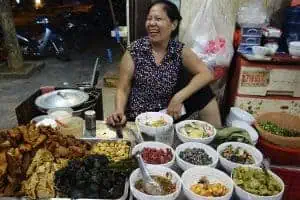
Last is an aspect of street food culture that is lost to most tourists: the aspect of discovery. There are few things in the world as satisfying as hitting the streets, finding a street food place that looks like it might be promising and having a great meal there. It gives you the feeling of a prospector who just struck gold. Several weeks ago, for example, I was strolling by a local market, taking in the sights and sounds of the metropolis surrounding me. I happened to pass by a stand selling bò lá lốt and decided to give it a try. Thirty minutes and eight delicious beef-and-vegetable wraps later, I sat back in my flimsy red plastic chair, utterly satisfied. The sizzle of beef being prepared for the next customer added to the metropolitan buzz of the Saigon night, as did the aroma of the warm herbs used in the dish.

Vietnamese Street Food Culture: A Brief History
The origins of the Vietnamese street food scene began in the Northern part of Vietnam in the early 1900s. Some entrepreneurial soul in the village of Van Cu, near Hanoi, came up with the bright idea of hauling around barrels of soup balanced over his shoulder on a flexible yoke. The idea soon caught on like wildfire. Surprisingly, phở, possibly the most famous Vietnamese street food, was not actually invented until after those mobile soup vendors became popular.
Over time, vendors began to diversify the foods they sold. They began to include not only phở but also dishes like broken rice (cơm tấm) and cakes (bánh). Travelers and locals appreciated the quick, delicious, freshly prepared meals, and they were extremely inexpensive to maintain for the seller, who didn’t have to pay for much more than ingredients.
The next innovation in Vietnamese street food came when many vendors tired of moving around all day. As Vietnamese urban areas became more densely populated, the sellers realized they did not need to be mobile in order to get customers — the customers would come to them. Staying put also had a host of other benefits. For instance, it was a lot less tiring for the vendors. People always knew just where a specific vendor could be found. It allowed the vendors to put out plastic chairs and tables so people eating the food would have somewhere to sit and relax. And maybe most importantly, it gave the sellers more space to spread out, which meant they could prepare slightly more complex dishes — the meals that are still popular kinds of Vietnamese street food today.
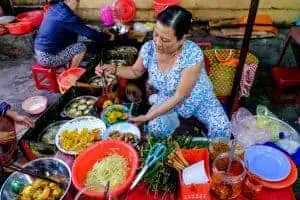
Still, though, the street food shops were not truly stationary. To avoid the costs associated with officially establishing a business, the owners made sure everything, including the tables, chairs, and food prep stations, could be rolled away or loaded onto a vehicle at the end of business hours. This mobility also came in handy when the police came by, as it was — and technically still is — illegal to set up sidewalk businesses without a license in Vietnamese cities.
But why has the Vietnamese street food culture endured and strengthened, while in most other places restaurants have become the norm? The answer lies in Vietnam’s culture, which is particularly good at preserving its time-honored social activities. Vietnam has withstood a lot in the past century. During most of that time, it has been an impoverished country. Starting a street food stand has always been a popular way to make a bit of extra money since it has such a low overhead cost. The Vietnamese are also resilient people and have always found time to celebrate little things, even when going through hard times. They have a time-honored tradition of going out together every now and then even if they can’t spend too much money, and that has kept the street food culture alive.
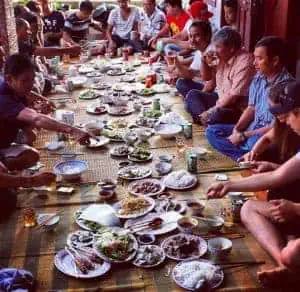
Although nowadays many Vietnamese street food vendors could afford to move into a more permanent establishment if they wanted to, mobile street eats are now such a big part of urban Vietnamese culture that they choose not to. Vietnam’s street food culture may have been born out of necessity, but locals have grown to love it. The most successful of these “new wave” street food sellers are able to make a fantastic living, in fact. Not only do they bypass a lot of red tape by selling on the street, but they are also able to charge just as much as an indoor restaurant if their food is of especially high quality. Multiply the cost by the huge amount of in-and-out customers that street food can attract, and you’re looking at a pretty impressive nightly income.
Locals also have more money, so a sidewalk meal is not just for celebratory occasions anymore. In fact, most Vietnamese people (and most visitors to the country) enjoy street food at least once per day. It’s a part of the country’s cultural fabric and a necessary inclusion on any list of things to try in Vietnam.
Nhậu: Eating and Drinking for No Particular Reason
One of the things visitors love most about Saigon is the tradition of communal celebration that is woven into the culture. And possibly the best illustration of this behavior is a phenomenon known in Vietnamese as nhậu. On any given night, even if there is no particular occasion to celebrate, a large group of Vietnamese adults may go out together to eat, drink, and be merry. We’re not just talking about any meal, either; nhậu always centers around beer or some other form of light alcohol, whether beer (bia) or liquor (rượu). The actual food portion of the meal is always heavy on protein and light on carbs, so as to make room for more booze. So instead of rice or noodles with sauces and add-ons, you can expect a nhậu meal to consist instead of barbecued meat (thịt nướng) and platters of shellfish (ốc).
Because nhậu food is different than typical street food, there are special establishments dedicated to providing parties with all they need for a perfect sidewalk banquet. These establishments will serve every kind of meat imaginable and, of course, very reasonably-priced beer. Most nhậu eateries are also frequented by on-foot street vendors selling small plastic bags of traditional Vietnamese snacks. Khô bò (spiced beef jerky), đậu phộng muối ớt (chili salt peanuts), and da cá (deep-fried fish skin) are several examples of snacks that Vietnamese love to consume when they nhậu.

There are several qualities that signify an establishment is a place to đi nhậu. The first is that nhậu places are built on a large, flat area of cement. Dozens of short plastic or aluminum tables and chairs will be laid out on this space. During business hours, the floor of the eating area, especially under the tables, will be littered with empty beer bottles or cans, used napkins, and shellfish husks. The debris may at first seem offputting to someone not used to it, but in Vietnamese culture, the messy aftermath of a nhậu session seems festive and inviting, like the confetti and glimmering beads left strewn on the floor after a great New Year’s Eve party.
As noted above, much of Vietnam’s recent history is steeped in poverty. It was not until recently that the average family became able to take a night to eat and drink recklessly for no particular reason. Because of this fact, nhậu establishments are a newer addition to the Vietnamese street food scene than the traditional hủ tiếu and gỏi cuốn stands you may pass during your urban adventures. That being said, they are an indispensable part of street culture in Vietnamese cities, especially in the southern part of the country. No street food education is complete without a few chances to đi nhậu.
Where to Find the Best Street Food in Saigon
Finding good street food to try in Vietnam is not always easy, though, especially for tourists. There are an overwhelming amount of places to sample, some of them delicious and distinct, but many of them duds. You definitely owe it to yourself to do your homework and learn about Vietnam’s street food culture in depth or at least go on your street food adventure with someone who has already done so.
District Specialties
Nowadays, street food is everywhere in Vietnamese cities. Walk down a street in Hanoi, and you’ll find different dishes than in Danang, where you’ll find very different choices than in Saigon. The specialties even vary from district to district within cities.
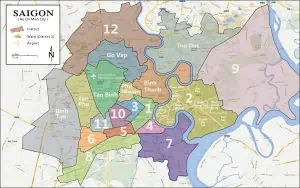
Ốc, Phá Lấu — District 4
Three of District 4’s most distinguishing features are that:
-
- It is known for its rich street food culture.
- It has an extremely high population density (almost twice that of District 1).
- It is literally an island, a triangular district connected to surrounding areas only by bridges.
These three factors have come together to produce an incredible shellfish street food scene. Streets like Vinh Khanh are veritable paradises for seafood lovers, with crowded shops lining the street on either side.
Phá lấu is a spicy and creamy dish comparable to red curry, but instead of fish or chicken, it is made with whole pig organs. For a reason lost to the sands of time, the bustling streets of District 4 have become known for producing the best versions of the dish Vietnam has to offer. For fantastic phá lấu and a wide variety of other street eats, walk down Xom Chieu Street and Vinh Khanh Street.
Wontons — District 5
If your travels take you to District 5, you’ll notice red slips of paper adorned with Chinese characters hanging above many doors or behind windows. That’s because District 5 is Ho Chi Minh City’s Chinatown. Communities of Chinese immigrants have flocked there for decades, and they brought their distinctive recipes with them. That is not to say Chinese dishes are not served elsewhere in the city, but district 5 definitely does them best. Wontons (hoành thánh) are the most popular, although you can also find dim sum (há cảo) and Chinese noodle dishes being peddled at street food stalls wherever you look, and especially on food streets like Nguyen Kim and Nguyen Trai.
The point is, a single Vietnamese city is varied in terms of its street food culture and landscape. Just going to one market with a lot of different street foods is not enough to give you a good sampling of the city’s street food scene. Even exploring an entire district is not enough. The only way to truly get a good taste of what Saigon’s street food vendors have to offer is taking a tour like The XO Foodie Tour that spends a good amount of time darting between districts.
BBQ, hotpot — District 8
District 8 has come to be known as where the locals come to party (see the section above on “nhậu,” the Vietnamese custom of celebratory eating and drinking for no particular reason). You can find large roadside establishments grilling up fresh meats and vegetables here every night until the early hours of the morning. The raw barbecue (thịt nướng) is generally brought to the table along with a portable miniature grill. Customers can then cook their own food just how they like it. Stroll down some heavy traffic streets such as Duong Ba Trac or Pham The Hien to discover these establishments.
The most popular party dish in District 8 has a bit more distinctly Vietnamese flair. “Lẩu” is the Vietnamese word for “hotpot.” Places that serve the dish will carry a bowl of tangy spiced broth to the table and will heat it at the table using a hot plate. Like with Vietnamese barbecue, they will supply a dish of uncooked meats and vegetables, along with some noodles. The customer then creates their own dish by adding the ingredients to the boiling broth in whatever manner they choose and then waiting a few minutes for it to cook to perfection. Experience this dish for yourself at District 8 food hubs like Xom Cui Market.
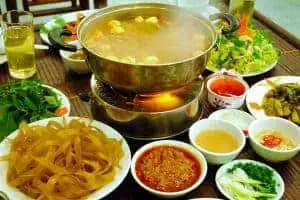
| District | Specialties | Notable Food Streets | Distance from Center |
|---|---|---|---|
| 4 | Pha lấu Ốc | Kinh Khanh Xom Chieu Doan Van Bo | 2.5km |
| 5 | Wontons Dumplings Fried Noodle Dishes | Nguyen Kim Nguyen Trai Nguyen Thoi Trung | 4.5km |
| 8 | Barbecue Lẩu hotpot | Pham The Hien Hung Phu Xom Cui Market | 7km |
| 10 | Sweet soup (chè) | Su Van Hanh Nguyen Tri Phuong To Hien Thanh | 4.5km |
The “Sidewalk Revolution”
In early 2017, Ho Chi Minh City officials began a campaign to clean up the sidewalks and return them to their original purpose — pedestrian walkways. This meant, among other things, cracking down on the street food vendors that were crowding many of the sidewalks throughout the city. There was immediate retaliation from locals, who complained that street food was part of Vietnamese culture and could not be taken away. As a compromise, officials designated certain areas as “street food markets” and allowed vendors to set up there without facing any possible repercussions.
One example of this kind of market that many tourists stumble across is the street food emporium adjacent to Ben Thanh market. The covered tent of the evening bazaar houses rows upon rows of food stalls, all of them as neat and clean as the vendors at a mall food court. The food is not as low-priced as one would imagine of Vietnamese street food, although it is, according to reviews, very tasty. After ordering, customers can find a seat at one of the long wooden tables at the front of the tent. They can also wait for their food like at a traditional street food location, but the sellers will be happy to bring it to the tables when it is ready.
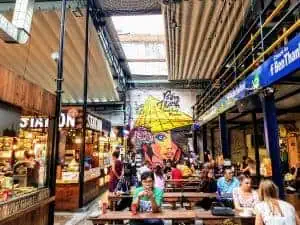
Nowadays, many of the most popular and highest quality street food vendors have moved into designated street food markets similar to the one across from Ben Thanh. The markets are delicious and convenient, but, unfortunately, they lack somewhat in authenticity. Street food was invented with the intended venue being a sidewalk stand surrounded by the hustle and bustle of the city. In comparison, eating it at one of the long tables found in a street food market seems a bit dull.

There are still many Ho Chi Minh City street food vendors who have stuck to the sidewalks. However, a portion of those that do still deal in the streets are of low quality. Poor hygiene and “shortcut” cooking methods that sacrifice flavor are common at such places.
The key to a successful Ho Chi Minh City street food excursion is to find the best of both worlds. You don’t want to eat somewhere serving low-quality food, although that place may provide an authentic street food atmosphere. But you also don’t want to eat somewhere that feels artificial, even if the food there tastes great. What you really want is somewhere that both feels authentic and tastes excellent. Somewhere where you can smell, hear, and see the pulse of the city around you, and at the same time give your taste buds a reminder of why people love Saigon’s street food.
This is why many tourists in pursuit of a delicious, authentic street food experience turn to the pros. As stated previously, Saigonese locals love street food, and they are eager to share the best of their city’s street food culture with visitors. By joining a tour like The XO Foodie run by XO Tours, you can be let in on a bit of Saigon’s diverse street food magic.
Is it safe to eat street food in Vietnam?
Yes, it is generally safe. It’s a good idea to stick to more reputable street food vendors who have a reputation to uphold. However, even lesser street food is much more hygienic than most tourists have been led to believe. For a much more detailed guide on how to identify unsafe street food and what types of street foods are particularly unsafe, head over to our popular blog post on food safety in Vietnam.





